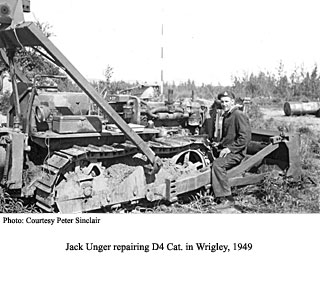Peter Sinclair (page4) ---
Tales
from the Territories : Wrigley Station
By Peter Sinclair
Vehicle
Problems. The first vehicle casualty was the D4 Cat that had been on loan
to Good Hope to install a radial ground. It was returned on the last southbound
boat of the season and was received with a cracked block. Someone had not
paid attention to the anti-freeze level before shipping it after freezing
temperatures had arrived. The first problem was how to get a dead piece of
machinery off the Barge. We used the D7 to winch it around the deck, then
dozed a ramp to the deck, winched it off and hauled it into camp.
This
left the D7 for airstrip maintenance and all the hauling duties. In early
summer, 1949, Hal Zinn and I were bringing in a load from the beach when
the Cat broke a track on the hill. We pulled the track back together with
come-alongs and wove it with wire rope. The tractor was slowly moved back
to base - walking alongside with crowbars to ease the broken part over the
drive sprocket. We had no idea how to repair the tracks. Track pins are put
in using a hydraulic press. That's when S/Sgt Alex Lowe came in from Ft.
Simpson where he was in charge of the transmitters and the Cat 4600 power
plants.
Alex knew what to do about the Cat tracks. With the broken track lying on
the ground fore-and-aft with the track plates removed, oxy-acetylene heat
was applied and the track pins hammered out. New track links and two-piece
track pins were then installed, track plates replaced, and the track tensioned
- we were back in business.
In
late winter the RCAF delivered the new block and replacement parts for the
D4. Alex had stripped the engine while waiting for the track parts, then
started in rebuilding the engine. I was on evening shifts and was able to
get in a week as mechanic's helper on the D4.
The next vehicle casualty was the 3-ton stake truck, the clutch of which
gave out after too many trips to the beach while the cats were out of service.
Cpl Ray Bebeau and Signm. Jack Unger, vehicle mechanics from Calder, came
in to replace the clutch. That is when they had the
Bear Hunt.

|
|
Footwear.
The army-issue winter footwear was an ankle-high felt boot. This would have
been OK around the station but was useless on the icy cold deck plates of
the Cats. I had my duffle socks made by one of the local Indian ladies through
the HBC Factor. The others already had theirs from previous stations.
With a pair of thick wool stockings, foot duffle, ankle duffel, a felt insole
and a pair of high cut cowhide moccasins mail-ordered from T. Eaton Co., your
feet did not freeze even sitting on the Cat.
In late 1949 the system sent in flight boots and new style parkas. The new
boots were a welcome addition but I found the old style B parka was better
for Cat. driving.

Return to Top of Page
Return to People page
Back to other Peter Sinclair Pages [1] [2]
[3] [4] [5]
[6] [7] [8]
[9]
Go to Stories page